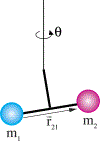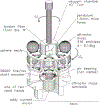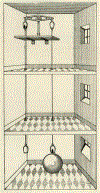Invited Review Article: Measurements of the Newtonian constant of gravitation, G
- PMID: 29195410
- PMCID: PMC8195032
- DOI: 10.1063/1.4994619
Invited Review Article: Measurements of the Newtonian constant of gravitation, G
Abstract
By many accounts, the Newtonian constant of gravitation G is the fundamental constant that is most difficult to measure accurately. Over the past three decades, more than a dozen precision measurements of this constant have been performed. However, the scatter of the data points is much larger than the uncertainties assigned to each individual measurement, yielding a Birge ratio of about five. Today, G is known with a relative standard uncertainty of 4.7 × 10-5, which is several orders of magnitudes greater than the relative uncertainties of other fundamental constants. In this article, various methods to measure G are discussed. A large array of different instruments ranging from the simple torsion balance to the sophisticated atom interferometer can be used to determine G. Some instruments, such as the torsion balance can be used in several different ways. In this article, the advantages and disadvantages of different instruments as well as different methods are discussed. A narrative arc from the historical beginnings of the different methods to their modern implementation is given. Finally, the article ends with a brief overview of the current state of the art and an outlook.
Figures



















Similar articles
-
Precision measurement of the Newtonian gravitational constant.Natl Sci Rev. 2020 Jul 22;7(12):1803-1817. doi: 10.1093/nsr/nwaa165. eCollection 2020 Dec. Natl Sci Rev. 2020. PMID: 34691518 Free PMC article.
-
Precision measurement of the Newtonian gravitational constant using cold atoms.Nature. 2014 Jun 26;510(7506):518-21. doi: 10.1038/nature13433. Epub 2014 Jun 18. Nature. 2014. PMID: 24965653
-
Measuring the Newtonian constant of gravitation G with an atomic interferometer.Philos Trans A Math Phys Eng Sci. 2014 Oct 13;372(2026):20140030. doi: 10.1098/rsta.2014.0030. Epub 2014 Sep 8. Philos Trans A Math Phys Eng Sci. 2014. PMID: 25202001 Free PMC article.
-
History and progress on accurate measurements of the Planck constant.Rep Prog Phys. 2013 Jan;76(1):016101. doi: 10.1088/0034-4885/76/1/016101. Epub 2012 Dec 18. Rep Prog Phys. 2013. PMID: 23249618 Review.
-
The BIPM measurements of the Newtonian constant of gravitation, G.Philos Trans A Math Phys Eng Sci. 2014 Oct 13;372(2026):20140032. doi: 10.1098/rsta.2014.0032. Epub 2014 Sep 8. Philos Trans A Math Phys Eng Sci. 2014. PMID: 25201995 Review.
Cited by
-
Precision measurement of the Newtonian gravitational constant.Natl Sci Rev. 2020 Jul 22;7(12):1803-1817. doi: 10.1093/nsr/nwaa165. eCollection 2020 Dec. Natl Sci Rev. 2020. PMID: 34691518 Free PMC article.
-
CODATA Recommended Values of the Fundamental Physical Constants: 2018.J Phys Chem Ref Data. 2021 Sep;50(3):033105. doi: 10.1063/5.0064853. Epub 2021 Sep 23. J Phys Chem Ref Data. 2021. PMID: 36726646 Free PMC article.
-
Ultra-weak gravitational field detected.Nature. 2021 Mar;591(7849):209-210. doi: 10.1038/d41586-021-00591-1. Nature. 2021. PMID: 33692552 No abstract available.
-
Gravitationally induced decoherence vs space-time diffusion: testing the quantum nature of gravity.Nat Commun. 2023 Dec 4;14(1):7910. doi: 10.1038/s41467-023-43348-2. Nat Commun. 2023. PMID: 38049417 Free PMC article.
-
CODATA recommended values of the fundamental physical constants: 2018.Rev Mod Phys. 2021 Apr-Jun;93(2):025010. doi: 10.1103/RevModPhys.93.025010. Epub 2021 Jun 30. Rev Mod Phys. 2021. PMID: 36733295 Free PMC article.
References
-
- Newton I, Philosophiae Naturalis Principia Mathematica (Sumptibus Societatis, 1687).
-
- Einstein A, Die Feldgleichungen der Gravitation, Sitzungsberichte der Königlich Preußischen Akademie der Wissenschaften (Berlin, 1915), pp. 844–847.
-
- Gillies GT, “The Newtonian gravitational constant: An index of measurements,” Metrologia 24(S), 1 (1987).
-
- Thompson M and Ellison SLR, “Dark uncertainty,” Accredit. Qual. Assur 16(10), 483 (2011).
Grants and funding
LinkOut - more resources
Full Text Sources
Other Literature Sources
Miscellaneous

